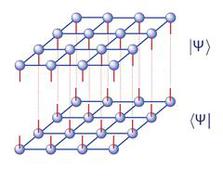Simulation and Numerical Techniques
Numerical simulations have established themselves as a third mainstay of science next to experiment and analytical theory. These simulations enable insights into new corners of science where experiments cannot be performed or where analytical evaluations are impossible. They also complement and guide experiments by providing ab-initio input from theoretical models and help theory to nonperturbatively solve differential equations, complex minimization problems or high-dimensional integrals.
The portfolio of the groups within the WPC using numerical simulation techniques is very broad. It encompasses:
- simulations of lattice field theories https://nic.desy.de (see also pricture)
- study of astroparticle processes including turbulence
- Monte Carlo event generators
- out-of-equilibrium processes
- simulations of materials
- tensor networks https://tensornetwork.org (see also picture)
- quantum simulations https://qt.eu/qtflag/ (see also picture)
- Simulation of high-intensity x-ray matter interactions http://www.desy.de/~xraypac/xatom.html
- advanced simulation techniques within projects of the graduate school DASHH
Main representative
Activities of this scientific pillar
Lecture courses for this scientific pillar can be found here.
Seminars of relevenace for this scientific pillar are collected here.




